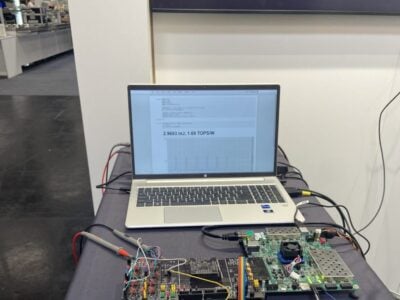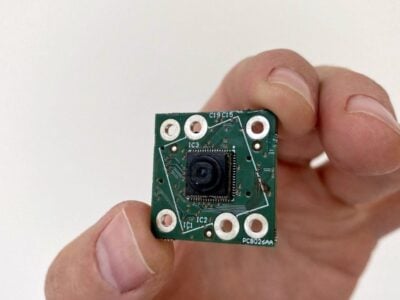
The Accellera EDA standards organisation is exploring the need for standards for AI frameworks as more software and Chinese companies join the group.
This is raising key questions on the role of standards in the global semiconductor industry as Lu Dai, chair of the Accellera EDA standards group, tells Nick Flaherty at the DVcon Europe conference in Munich last week.
Accellera is an independent global body that works alongside the Si2 standards group and the IEEE to develop standards for EDA tools. It has been a sponsor of the Design & Verification Conference (DVcon), which celebrated ten years in Europe last week.
“DVcon Europe for Accellera is a poster child, doubling in the last ten years,” said Dai, who is Senior Director of Engineering at Qualcomm. “DVcon Europe became financially independent very quickly with a stable volunteer steering committee that says year after year and they rotate the chair among themselves which means everyone gets trained and everyone can help each other out and that’s the model that we promote to other regions.
“They are from the user companies so they can be very neutral in the selection of the programme and the invited keynotes for example they had Audi on the future of the selfdriving car five years ago and we are trying to push that approach to other DVcon events and back to the US,” he said.
Accellera is now seeing more software companies and Chinese companies joining.
“We are starting to have more software companies joining with Microsoft and Apple, and having them joining your standards body is a good thing. We also have IP companies joining such as SiFive and they have their own proprietary tool flow that is not based on SystemC, and we are looking at whether they want to adopt some of the legacy flow standards,” Lu Dai, chair of the Accellera tells eeNews Europe.
“We are also starting to see Chinese EDA companies joining and these are looking for recognition beyond China to sell to other markets.”
- Peer-reviews from Huawei banned by IEEE
- IEEE survey eyes impact of technology in 2023
- Accellera approves universal Verification Methodology (UVM) standard
Accellera focusses on the development of standards for the front end development of chips, with simulation and emulation, while the Silicon Integration Initiative (Si2) has a focus on the back end physical verification.
“For example the Accellera Unified Power Format (UPF) standard is very specific and is more for the IP companies. The Si2 Unified Power Model (UPM) is used by physical designers but also by system architectures for power models, so that has more foundry companies,” he said.
The group also works closely with the IEEE standards activity, where the role of Chinese companies has been highlighted.
“We have 24 standards and additional libraries, reference designs and proof of concepts, and we feed into the IEEE standards process. If one of our standards gets popular we donate it to the IEEE but the modification by the IEEE is quite minor.
“We are aiming to have 10 IEEE standards in 10 years, and we are in the middle of that and we are negotiating the next agreement with them. It is important. I hope the IEEE also recognise the importance as the standards go straight into adoption, it’s a two way street.”
He points to the IPSA specification developed by Accellera that went straight to IEEE for EDA integration as the IEEE P3194 standard. This defines how to pass security attack data to the EDA tools so people want that as soon as possible
Cross Domain Crossing
Accellera is working on standards for functional safety a data model whitepaper for LRM coming shortly, It has also proposed a specification for a cross domain timing.
“For Clock Domain Crossing we are working on merging the knowledge in the industry,” he said. “It’s a back end issue that you have to fix in the front end. This is one of the main issues for silicon companies that need to go through a respin if they do not have a good enough methodology. It’s very tough to debug and if you do find a bug its very difficult to fix without a respin, so we need to fix that in the front end.
- Working group proposed for federated simulation
- Working group looks at clock domain crossing verification
- Clock Domain Crossing draft standard available
There is also a Federated Simulations proposed working group that would allow different simulation tools running on different system to share data.
“The primary driver for this is automotive and that’s European centric and there’s ongoing discussions in aerospace as well. This just started and I expect to SystemC to cover this plus the aerospace and automotive areas.”
“They haven’t finished the scoping yet but they are starting with the APIs and you are trying to get a common API so the tools can talk to each other. If that requires a common data format then it may need that, but they will present the scope to the board for approval to initiate the working group likely early next year as we have a maximum of 6 months so they will have to finish by February for DVcon in the US. It may not touch data format.”
The group is also looking at standards for machine learning and AI in front end EDA tools alongside Si2. Synopsys and Cadence Design Systems have both been adding ML and generative AI into their tools.
“We were considering an AI working group as Si2 has an AI group and are working on data formats. It is a challenging topic and for the algorithms to work well they need large amounts of data. Most likely the EDA companies will come up with a way for the customer to take a tiered approach with some public data sharing to the effectiveness of an algorithm is up to the customer.”
“We are trying to see if there is a way to have a happy middle with a way to extract the data from the physical design log that doesn’t expose the proprietary information, but we don’t know how to do that as an industry at the moment,” he said.
He points to the lead that China has in this area.
“In China the government can force a company to open up the data so the likelihood is that Chinese EDA companies will have better algorithms as the data is shared which has been shown with facial recognition. So China’s AI algorithm effectiveness is much higher. I think Si2 needs to do something but it won’t address the front end RTL simulations.”
“The front end [development] can be pretty expensive, debug, you can use AI and the front end engineers are still located in high cost regions, its very difficult to do a hand off. If you can do AI for the front end with in house debug triage without having to do a lot of tracing to figure out where a bug is then you need less verification.”
But does standardising AI in EDA tools limit the opportunities for innovation?
“There is always resistance to standards but you can always separate the part that is beneficial to everyone. If you don’t allow AI data sharing its detrimental to everyone. If you have sufficient data sharing and people can come up with different algorithms, but without the data you can’t build the algorithms,” he said.
“That’s typically for standards work, people see the benefits for themselves. We cannot count on people to see it as benevolent or temporary, you have to make sure the parties can benefit from the work, and that could be in the business or it could be wider recognition.”
“Standards in China have two approaches. The recent one is that the companies and even the government are trying to take more leadership and get more recognition so the standards will work better for China and to compete in the international community and its similar to the western approach to guide the standards.”
“The Chinese standards effort has matured to the next stage to stick to international standards to allow companies to compete on the world stage. The challenge in the current climate is to kick the Chinese companies out of the standards activities and that could backfire as if they give up the possibility of playing on the world stage they go back to the previous model and the only thing they can then do is to limit imports.”
It is unlikely that EDA standards will see trade restrictions like EDA tools or leading edge graphics processors or AI accelerators, he says.
“The standards work from US companies has been allowed as an exception with IEEE, IEC, ISO, for published standards. Then it’s about the definitions of controlled technology. EDA technology itself will become a controlled technology but EDA standards will not.”
“The algorithms are proprietary and are not being shared and the information shared in standards does not include proprietary technologies. It’s whether the export control is for the technology or for business. If you bar China from joing Accellera for example then it will hurt the China business even if there is no proprietary technology.”
“From an industry perspective its much better to have sharing,” he said.
 If you enjoyed this article, you will like the following ones: don't miss them by subscribing to :
eeNews on Google News
If you enjoyed this article, you will like the following ones: don't miss them by subscribing to :
eeNews on Google News



